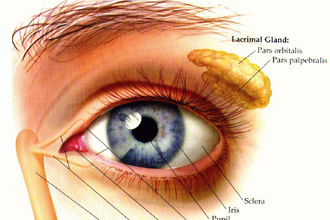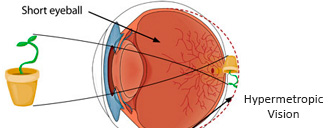
At Khandwala Eye Hospital You will be cared by an excellent Ophthalmologists for both your preoperative and postoperative visits. Here, Laser Vision Correction includes a pre-procedure visit and a thorough examination, the procedure itself, and all follow-up care to ensure the best possible results.
Understanding Cornea..
Opening doors to a better Vision..
The cornea is the clear outermost layer of the eye. It covers the pupil, iris, and anterior chamber. The cornea's main function is to refract light. The cornea is composed of proteins and cells. It does not have blood vessels, unlike most of the tissues. Although the cornea is clear and seems to lack substance, it is actually a highly organized group of cells and proteins. Unlike most tissues in the body, the cornea contains, under normal circumstances, no blood vessels to nourish or protect it against infections. Instead, the cornea receives its nourishment from the tears and aqueous humor that fills the chamber behind it. The cornea must remain transparent to refract light properly, and the presence of even the tiniest blood vessels can interfere with this process. To see well, all layers of the cornea must be free of any cloudy or opaque areas.

Cross section of an Eye.
At K.E.H, Our unparalleled expertise and state-of-the-art equipment allow us to offer excellent medical and surgical treatment of the full range of routine, complex and high-risk corneal and external diseases.

Function of Cornea
It helps to shield the rest of the eye from germs, dust, and other harmful matter. The cornea shares this protective task with the eyelids, the eye socket, tears, and the sclera, or white part of the eye. The cornea acts as the eye's outermost lens. It functions like a window that controls and focuses the entry of light into the eye. The cornea contributes between 65-75 percent of the eye's total focusing power.A Walkthough Video of Cornea's role in the Eye..
What does the cornea do ?
The cornea and lens of the eye are built to focus light on the retina, which is the light-sensitive tissue at the back of the eye. When light strikes the cornea, it bends—or refracts—the incoming light onto the lens. The lens refocuses that light onto the retina, which starts the translation of light into vision. The retina converts light into electrical impulses that travel through the optic nerve to the brain, which interprets them as images.The refractive process the eye uses is similar to the way a camera takes a picture. The cornea and lens in the eye act as the camera lens. The retina is like the film (in older cameras), or the image sensor (in digital cameras). If the image is not focused properly, the retina makes a blurry image.The cornea also serves as a filter that screens out damaging ultraviolet (UV) light from the sun. Without this protection, the lens and the retina would be exposed to injury from UV rays.
What are some common conditions that affect the cornea ?

Injuries :
After minor injuries or scratches, the cornea usually heals on its own. Deeper injuries can cause corneal scarring, resulting in a haze on the cornea that impairs vision. If you have a deep injury, or a corneal disease or disorder, you could experience:- Pain in the eye.
- Sensitivity to light.
- Reduced vision or blurry vision.
- Redness or inflammation in the eye.
- Headache, nausea, fatigue.

Allergies :
The most common allergies that affect the eye are those related to pollen, particularly when the weather is warm and dry. Symptoms in the eye include redness, itching, tearing, burning, stinging, and watery discharge, although usually not severe enough to require medical attention. Antihistamine decongestant eyedrops effectively reduce these symptoms.Rain and cooler weather, which decreases the amount of pollen in the air, can also provide relief.
For more information see Facts about Pink Eye (Conjunctivitis).

Keratitis :
Keratitis is an inflammation of the cornea. Noninfectious keratitis can be caused by a minor injury, or from wearing contact lenses too long. Infection is the most common cause of keratitis. Infectious keratitis can be caused by bacteria, viruses, fungi or parasites. Often, these infections are also related to contact lens wear, especially improper cleaning of contact lenses or overuse of old contact lenses that should be discarded. Minor corneal infections are usually treated with antibacterial eye drops. If the problem is severe, it may require more intensive antibiotic or antifungal treatment to eliminate the infection, as well as steroid eye drops to reduce inflammation.
Dry Eyes :
Dry eye is a condition in which the eye produces fewer or lower quality tears and is unable to keep its surface lubricated.The main symptom of dry eye is usually a scratchy feeling or as if something is in your eye. Other symptoms include stinging or burning in the eye, episodes of excess tearing that follow periods of dryness, discharge from the eye, and pain and redness in the eye.Sometimes people with dry eye also feel as if their eyelids are very heavy or their vision is blurred. For more detailed information about dry eye and its treatments, please see the NEI publication Facts about Dry Eye.Refractive Errors of the Eye..

Refractive errors occur when the curve of the cornea is irregularly shaped (too steep or too flat). When the cornea is of normal shape and curvature, it bends, or refracts, light on the retina with precision. However, when the curve of the cornea is irregularly shaped, the cornea bends light imperfectly on the retina. This affects good vision. The refractive process is similar to the way a camera takes a picture. The cornea and lens in your eye act as the camera lens. The retina is similar to the film. If the image is ot focused properly, the film (or retina) receives a blurry image. The image that your retina "sees" then goes to your brain, which tells you what the image is. When the cornea is curved too much, or if the eye is too long, faraway objects will appear blurry because they are focused in front of the retina. This is called Myopia, or nearsightedness.
 Hyperopia,(farsightedness) is a common type of refractive error where distant objects may be seen more clearly than objects that are near. However, people experience hyperopia differently. Some people may not notice any problems with their vision, especially when they are young. For people with significant hyperopia, vision can be blurry for objects at any distance, near or far.
Hyperopia,(farsightedness) is a common type of refractive error where distant objects may be seen more clearly than objects that are near. However, people experience hyperopia differently. Some people may not notice any problems with their vision, especially when they are young. For people with significant hyperopia, vision can be blurry for objects at any distance, near or far.

